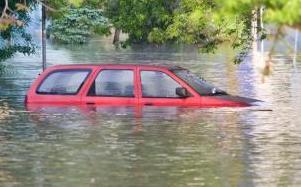 Getting a car working again after a flood takes more than just drying the carpets and turning the key.
Getting a car working again after a flood takes more than just drying the carpets and turning the key.
Whether a car was hit by rising waters or a torrential downpour owners should be cautious before starting or even moving their vehicle, according to the National Automobile Dealers Association.
“The amount of damage depends on how long a vehicle has been submerged and how deep,” Bill Underriner, NADA chairman, said in a statement. “A good rule of thumb is to take caution if a vehicle’s carpets have been wet for an extended period.”
NADA recommends that affected motorists contact their auto insurer before attempting to move a water-damaged vehicle.
“Do not try to start a vehicle that has been severely damaged by water,” Underriner said. “Starting a vehicle even in a damp condition could cause harm to the driver and the vehicle’s onboard computers and wiring. A short in the electrical system can cause a shock, or worse, a fire.”
Severe damage will result when water enters an engine through the air intake and internal systems were not designed to be submerged. Vehicle parts can start to rust in a matter of hours when underwater and transmission fluid and engine oil will be compromised if contaminated.
Water in fuel is another big problem that many car owners overlook as the damage can take months to appear, Underriner said. Water can seep in through the overflow valve or an improperly sealed gas cap. Rust in the gas tank and water running through the fuel system will do significant damage over time.
“Have any water-damaged vehicle thoroughly inspected by a certified service technician before driving it,” Underriner said.
Once the clean-up, reconditioning and rebuilding begins, it’s possible that water-damaged vehicles could return to the marketplace. Nefarious individuals may buy these vehicles, thoroughly clean them and attempt to resell them.
While there is no sure way to know if a vehicle has been damaged by flooding, NADA offers 10 inspection tips that may be used to detect water damage. A prospective buyer can spot a flooded vehicle by following these simple steps:
1. Check the vehicle’s title history by VIN through commercially available vehicle history reports like Carfax (www.carfax.com), Experian’s Auto Check (www.autocheck.com), or through the National Insurance Crime Bureau’s VinCheck (https://www.nicb.org/theft_and_fraud_awareness/vincheck). The report may state whether a vehicle has sustained flood damage.
2. Examine the interior and the engine compartment for evidence of water and grit from suspected submersion.
3. Check for recently shampooed carpet.
4. Look under the floorboard carpet for water residue or stain marks from evaporated water not related to air-conditioning pan leaks.
5. Inspect for rusting on the inside of the car and under interior carpeting and visually inspect all interior upholstery and door panels for any evidence of fading.
6. Check under the dashboard for dried mud and residue, and note any evidence of mold or a musty odor in the upholstery, carpet or trunk.
7. Check for rust on screws in the console or other areas where the water would normally not reach unless submerged.
8. Look for mud or grit in alternator crevices, behind wiring harnesses and around the small recesses of starter motors, power steering pumps and relays.
9. Complete a detailed inspection of the electrical wiring system looking for rusted components, water residue or suspicious corrosion.
10. Inspect the undercarriage of other components for evidence of rust and flaking metal that would not normally be associated with late model vehicles.
While these inspection suggestions will not detect flood damage in every case, they do provide some information to protect the consumer from purchasing a vehicle damaged by water or flood.
“When in doubt, have the vehicle checked out,” Underriner said. “Your safety and your family’s safety are far too important to risk.”












